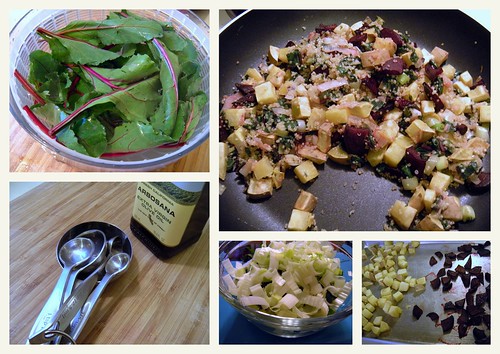Today we have had one of the rarest experiences in San Diego: autumn weather in early autumn. I know, right? Exciting! I won't say it's cold, of course. We still have our sliding glass doors open on every balcony. But it was gloomy, we had a smattering of rain, and I had beets in the fridge.
I love wintery foods. I have only recently discovered the majority of winter vegetables--the roots, gourds, and greens some people apparently grew up eating. I joined a CSA for fall/winter a couple years ago, to push me to learn to use stables such as beets, butternut squash, and kale. Now I love them. I get positively giddy when I see the winter squash at the farmers market. Because let's face it, most produce is available year-round in San Diego. But fall and winter is when I want to make the soups and braise the greens and so on.
Since the weather was being so accomodating, and because we're trying to eat at home more, I decided to break out a recipe I haven't made since last October. It was in the October issue of Living, and uses beets, sweet potato, leek, quinoa, and a poached egg. While it was actually billed as a brunch, poached eggs over, well, anything is a dinner favorite around here.

Fall-Vegetable and Quinoa Hash with Poached Eggs
from Martha Stewart Living
1 large sweet potato, cut into 1/2-inch cubes
2 1/2 teaspoons extra-virgin olive oil
Coarse salt and freshly ground pepper
2 beets, peeled and cut into 1/2-inch wedges, reserve half of the greens and rinse well
2-3 tablespoons of white vinegar
4 large eggs
1 leek, white and pale-green parts only, halved lengthwise, cut 1/4 inch thick, and rinsed well
1 cup cooked quinoa (from 1/4 cup dry)--I might use a little more next time.
3/4 teaspoon chopped fresh thyme
Preheat oven to 400 degrees.
Toss sweet potato with 1/2 teaspoon oil and 1/4-1/2 teaspoon salt, depending on how large your large potato is; spread in an even layer on half of a rimmed baking sheet. Toss beets with 1/2 teaspoon oil and 1/8 teaspoon salt; spread on other half of sheet, which prevents excessively pink potatoes. Roast, stirring halfway through, until tender, 35 to 40 minutes. I go ahead and combine them at the halfway point.
(Now the next steps are kind of awkward, timing-wise. Martha suggests poaching your eggs and setting them aside, and then going on to the final step, but I find the eggs get a little too cold. It isn't the end of the world, but I prefer to actually drop in my eggs towards the very end)
Once the potatoes and beets are in the oven and your timer is set for 15-20 minutes, thinly slice the beet greens. The beets at the Mercato are super-leafy, and I find the flavor a little too... well, it reminds me of lake water if I overdo the greens, but if you love the flavor, use 'em all. But I slice up about half of them--the prettiest ones.
I hate to say it, but when it comes to poaching eggs, Martha steered me wrong. I know! Shock! Horror! I tried following the magazine recipe for poaching eggs, and it was pretty much a disaster. If I hadn't had previous experience, dinner might have been ruined. The very best method for poaching eggs is the one I learned from Molly Wizenberg:
Fill a large skillet (I use a chef's pan) about 2/3 full of water--about 2 inches deep. Bring to a boil, then add 2-3 tablespoons of white vinegar and reduce to a simmer. Once the water is all a-tremble, crack an egg into a teacup or custard cup--I use a ramekin, but a thinner-lipped vessel is recommended by Molly and Martha. Gently lower the bottom of the cup into the water, then slowly tip the egg into the water, basically rolling/twisting the cup from beneath the egg. Don't hold the cup with the egg in the water too long, or the egg can cook in the cup.
If you think the white is spreading out too much, you can use a spoon to fold the white over the top of the yolk, or cup it all against the side of the pan for a moment--but I don't worry about a few whisps or strands. Allow the water to settle before adding the next egg. I can fit 3 eggs in my pan at once, which is perfect because I usually have one egg, and Matt two for dinner.
Cook each egg for 2-4 minutes, until the white is opaque from the edges right up to the yolk. Remove with a spatula and either place in a bowl of hot--but not too hot or the egg will keep cooking--water, or place on a clean tea towel. I like dropping the eggs on a towel for this dish, because excess water isn't the most appetizing.
Heat 1 1/2 teaspoons oil in a large nonstick skillet over medium heat. Add greens, leek, 1/4 teaspoon salt, and 1/4 teaspoon pepper; cook until tender and lightly browned, 8 to 10 minutes. Stir in quinoa, thyme, and vegetables; press down using a rubber spatula (this is when I also try to drop my eggs, but it's a little bit of juggling act). Cook until quinoa is warm, 1 to 2 minutes.
Divide hash onto 4 plates, then top with an egg. Or if you're just two, divide it as you like and save the leftovers for lunch tomorrow!

